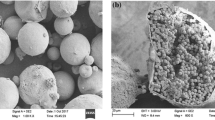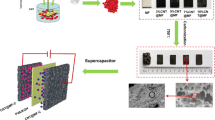Abstract
Carbon nanotube (CNT) has been intensively studied as supercapacitor electrode materials due to their high mechanical strength and excellent electrical conductivity. However, CNT with limited accessible surface area has low specific capacitance, which limits its application and development in supercapacitor. Herein, we have designed a thin N-doped porous carbon layer-modified CNT nanocomposite by template-free method. In this process, 3-aminophenol and formaldehyde rapidly self-assemble on the CNT in the presence of cationic surfactant CTAB, forming the composite of 3-aminophenol/formaldehyde (3-AF) resin and CNT. Due to the different polymerization degree of inside 3-AF resin, the soluble 3-AF resin oligomer was removed by acetone to form porous 3-AF resin and CNT@N-doped porous carbon (CNT@N-PC) was obtained by annealing process. The CNT@N-PC exhibited abundant porous structure, high specific surface area of 940 m2 g−1, excellent specific capacitance value of 224 F g−1 at 1 A g−1 and good cycle stability, demonstrating its potential as supercapacitor electrode materials.





Similar content being viewed by others
References
Lu HY, Li QW, Guo JH, Song AX, Gong CH, Zhang JW, Zhang JW (2018) Hierarchically porous carbon with high-speed ion transport channels for high performance supercapacitors. Appl Surf Sci 427:992–999
Zhang JL, Zhang WF, Han MF, Pang J (2018) One pot synthesis of nitrogen-doped hierarchical porous carbon derived from phenolic formaldehyde resin with sodium citrate as activation agent for supercapacitors. J Mater Sci Mater Electron 29:4639–4648
Choi BG, Hong J, Hong WH, Hammond PT, Park HS (2011) Facilitated ion transport in all-solid-state flexible supercapacitors. ACS Nano 5:7205–7213
Huang JY, Chen LD, Dong HW, Zeng Y, Hu H, Zheng MT, Liu YL, Xiao Y, Liang YR (2017) Hierarchical porous carbon with network morphology derived from natural leaf for superior aqueous symmetrical supercapacitors. Electrochim Acta 258:504–511
Staaf LGH, Lundgren P, Enoksson P (2014) Present and future supercapacitor carbon electrode materials for improved energy storage used in intelligent wireless sensor systems. Nano Energy 9:128–141
Wei L, Yushin G (2012) Nanostructured activated carbons from natural precursors for electrical double layer capacitors. Nano Energy 1:552–565
Cao XH, Yin ZY, Zhang H (2014) Three-dimensional graphene materials: preparation, structures and application in supercapacitors. Energy Environ Sci 7:1850–1865
Qie L, Chen WM, Xu HH, Xiong XQ, Jiang Y, Zou F, Hu XL, Xin Y, Zhang ZL, Huang YH (2013) Synthesis of functionalized 3D hierarchical porous carbon for high-performance supercapacitors. Energy Environ Sci 6:2497–2504
Zhang LL, Zhou R, Zhao XS (2010) Graphene-based materials as supercapacitor electrodes. J Mater Chem 20:5983–5992
Peng C, Zhang SW, Jewell D, Chen GZ (2008) Carbon nanotube and conducting polymer composites for supercapacitors. Prog Nat Sci 18:777–788
Ko JM, Kim KM (2009) Electrochemical properties of MnO2/activated carbon nanotube composite as an electrode material for supercapacitor. Mater Chem Phys 114:837–841
Borenstien A, Noked M, Okashy S, Aurbach D (2013) Composite carbon nano-tubes (CNT)/activated carbon electrodes for non-aqueous super capacitors using organic electrolyte solutions. J Electrochem Soc 160:A1282–A1285
Frackowiak E, Delpeux S, Jurewicz K, Szostak K, Cazorla-Amoros D, Beguin F (2002) Enhanced capacitance of carbon nanotubes through chemical activation. Chem Phys Lett 361:35–41
Bi RR, Wu XL, Cao FF, Jiang LY, Gu YG, Wan LJ (2010) Highly dispersed RuO2 nanoparticles on carbon nanotubes: facile synthesis and enhanced supercapacitance performance. J Phys Chem C 114:2448–2451
Jiang H, Li CZ, Sun T, Ma J (2012) A green and high energy density asymmetric supercapacitor based on ultrathin MnO2 nanostructures and functional mesoporous carbon nanotube electrodes. Nanoscale 4:807–812
Cai F, Kang YR, Chen HY, Chen MH, Li QW (2014) Hierarchical CNT@NiCo2O4 core–shell hybrid nanostructure for high-performance supercapacitors. J Mater Chem A 2:11509–11515
Yu YJ, Ouyang C, Gao Y, Si ZH, Chen W, Wang ZQ, Xue G (2005) Synthesis and characterization of carbon nanotube/polypyrrole core–shell nanocomposites via in situ inverse microemulsion. J Polym Sci Part A Polym Chem 43:6105–6115
Czerw R, Terrones M, Charlier JC, Blase X, Foley B, Kamalakaran R, Grobert N, Terrones H, Tekleab D, Ajayan PM, Blau W, Ruhle M, Carroll DL (2001) Identification of electron donor states in N-doped carbon nanotubes. Nano Lett 1:457–460
Sahoo NG, Rana S, Cho JW, Li L, Chan SH (2010) Polymer nanocomposites based on functionalized carbon nanotubes. Prog Polym Sci 35:837–867
Qian XF, Lv YY, Li W, Xia YY, Zhao DY (2011) Multiwall carbon nanotube@mesoporous carbon with core–shell configuration: a well-designed composite-structure toward electrochemical capacitor application. J Mater Chem 21:13025–13031
Liu C, Wang J, Li JS, Zeng ML, Luo R, Shen JY, Sun XY, Han WQ, Wang LJ (2016) Synthesis of N-doped hollow-structured mesoporous carbon nanospheres for high-performance supercapacitors. ACS Appl Mater Interfaces 8:7194–7204
Ni M, Huang ZH, Zhang XL, Liu JP, Qiao L, Yang W (2017) Hierarchical design of nitrogen-doped porous carbon nanorods for use in high efficiency capacitive energy storage. RSC Adv 7:22447–22453
Chen LF, Zhang XD, Liang HW, Kong MG, Guan QF, Chen P, Wu ZY, Yu SH (2012) Synthesis of nitrogen-doped porous carbon nanofibers as an efficient electrode material for supercapacitors. ACS Nano 6:7092–7102
Liu B, Liu YJ, Chen HB, Yang M, Li HM (2017) Oxygen and nitrogen co-doped porous carbon nanosheets derived from Perilla frutescens for high volumetric performance supercapacitors. J Power Sources 341:309–317
Chen L, Ji T, Mu LW, Zhu JH (2017) Cotton fabric derived hierarchically porous carbon and nitrogen doping for sustainable capacitor electrode. Carbon 111:839–848
Du J, Liu L, Hu ZP, Yu YF, Zhang Y, Hou SL, Chen AB (2018) Raw-cotton-derived N-doped carbon fiber aerogel as an efficient electrode for electrochemical capacitors. ACS Sustain Chem Eng 6:4008–4015
Luo GS, Huang HF, Lei CL, Chen ZZ, Wu XS, Tang SL, Du YW (2016) Facile synthesis of porous graphene as binder-free electrode for supercapacitor application. Appl Surf Sci 366:46–52
Rana M, Subramani K, Sathish M, Gautam UK (2017) Soya derived heteroatom doped carbon as a promising platform for oxygen reduction, supercapacitor and CO2 capture. Carbon 114:679–689
Béguin F, Szostak K, Lota G, Frackowiak E (2005) A self-supporting electrode for supercapacitors prepared by one-step pyrolysis of carbon nanotube/polyacrylonitrile blends. Adv Mater 17:2380–2384
Han JP, Xu GY, Ding B, Pan J, Dou H, MacFarlane DR (2014) Porous nitrogen-doped hollow carbon spheres derived from polyaniline for high performance supercapacitors. J Mater Chem A 2:5352–5357
Chen AB, Xia KC, Zhang LS, Yu YF, Li YT, Sun HX, Wang YY, Li YQ, Li SH (2016) Fabrication of nitrogen-doped hollow mesoporous spherical carbon capsules for supercapacitors. Langmuir 32:8934–8941
Liu XH, Zhou L, Zhao YQ, Bian L, Feng XT, Pu QS (2013) Hollow, spherical nitrogen-rich porous carbon shells obtained from a porous organic framework for the supercapacitor. ACS Appl Mater Interfaces 5:10280–10287
Liu YZ, Li YF, Su FY, Xie LJ, Kong QQ, Li XM, Ga JG, Chen CM (2016) Easy one-step synthesis of N-doped graphene for supercapacitors. Energy Storage Mater 2:69–75
Wang B, Qiu JH, Feng HX, Sakaia E, Komiyama T (2016) KOH-activated nitrogen doped porous carbon nanowires with superior performance in supercapacitors. Electrochim Acta 190:229–239
Jiang M, Zhang JL, Xing LB, Zhou J, Cui HY, Si WJ, Zhuo SP (2016) KOH-activated porous carbons derived from chestnut shell with superior capacitive performance. Chin J Chem 34:1093–1102
Guo HL, Gao QM (2009) Boron and nitrogen co-doped porous carbon and its enhanced properties as supercapacitor. J Power Sources 186:551–556
Zhang L, Xu L, Zhang YG, Zhou X, Zhang LT, Yasin A, Wang LL, Zhi KK (2018) Facile synthesis of bio-based nitrogen-and oxygen-doped porous carbon derived from cotton for supercapacitors. RSC Adv 8:3869–3877
Wang Q, Yan J, Wang YB, Ning GQ, Fan ZJ, Wei T, Cheng J, Zhang ML, Jing XY (2013) Template synthesis of hollow carbon spheres anchored on carbon nanotubes for high rate performance supercapacitors. Carbon 52:209–218
Acknowledgements
We thank the National Natural Science Foundation of China (21676070), Hebei Natural Science Foundation (B2015208109), Hebei Training Program for Talent Project (A201500117), Hebei One Hundred-Excellent Innovative Talent Program (III) (SLRC2017034), Hebei Science and Technology Project (17214304D, 16214510D).
Author information
Authors and Affiliations
Corresponding author
Rights and permissions
About this article
Cite this article
Zhang, Y., Liu, L., Zhang, L. et al. Template-free method for fabricating carbon nanotube combined with thin N-doped porous carbon composite for supercapacitor. J Mater Sci 54, 6451–6460 (2019). https://doi.org/10.1007/s10853-018-03290-x
Received:
Accepted:
Published:
Issue Date:
DOI: https://doi.org/10.1007/s10853-018-03290-x




